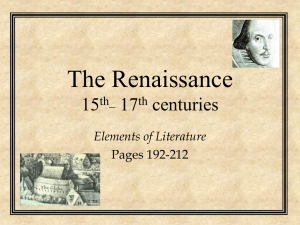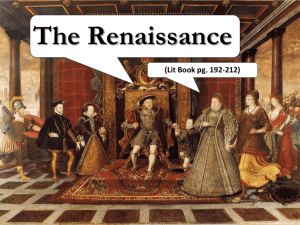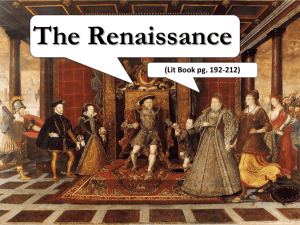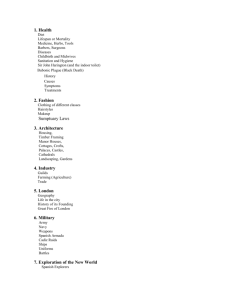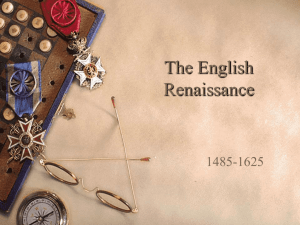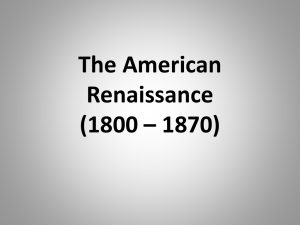Historical Background: The English Renaissance In
advertisement
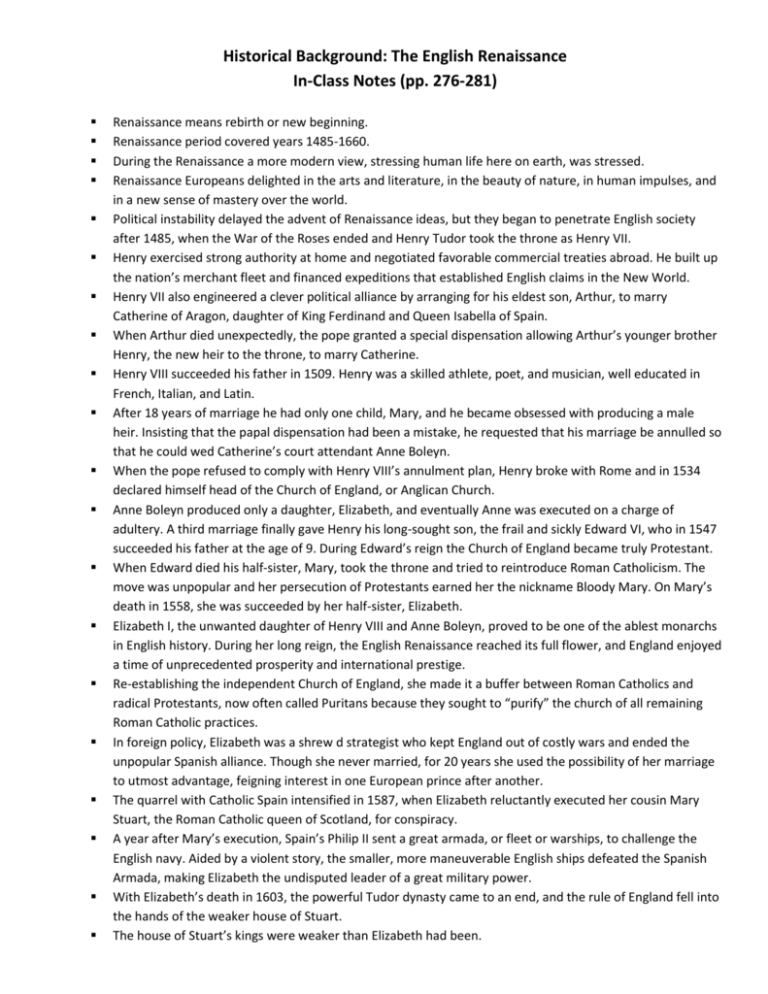
Historical Background: The English Renaissance In-Class Notes (pp. 276-281) Renaissance means rebirth or new beginning. Renaissance period covered years 1485-1660. During the Renaissance a more modern view, stressing human life here on earth, was stressed. Renaissance Europeans delighted in the arts and literature, in the beauty of nature, in human impulses, and in a new sense of mastery over the world. Political instability delayed the advent of Renaissance ideas, but they began to penetrate English society after 1485, when the War of the Roses ended and Henry Tudor took the throne as Henry VII. Henry exercised strong authority at home and negotiated favorable commercial treaties abroad. He built up the nation’s merchant fleet and financed expeditions that established English claims in the New World. Henry VII also engineered a clever political alliance by arranging for his eldest son, Arthur, to marry Catherine of Aragon, daughter of King Ferdinand and Queen Isabella of Spain. When Arthur died unexpectedly, the pope granted a special dispensation allowing Arthur’s younger brother Henry, the new heir to the throne, to marry Catherine. Henry VIII succeeded his father in 1509. Henry was a skilled athlete, poet, and musician, well educated in French, Italian, and Latin. After 18 years of marriage he had only one child, Mary, and he became obsessed with producing a male heir. Insisting that the papal dispensation had been a mistake, he requested that his marriage be annulled so that he could wed Catherine’s court attendant Anne Boleyn. When the pope refused to comply with Henry VIII’s annulment plan, Henry broke with Rome and in 1534 declared himself head of the Church of England, or Anglican Church. Anne Boleyn produced only a daughter, Elizabeth, and eventually Anne was executed on a charge of adultery. A third marriage finally gave Henry his long-sought son, the frail and sickly Edward VI, who in 1547 succeeded his father at the age of 9. During Edward’s reign the Church of England became truly Protestant. When Edward died his half-sister, Mary, took the throne and tried to reintroduce Roman Catholicism. The move was unpopular and her persecution of Protestants earned her the nickname Bloody Mary. On Mary’s death in 1558, she was succeeded by her half-sister, Elizabeth. Elizabeth I, the unwanted daughter of Henry VIII and Anne Boleyn, proved to be one of the ablest monarchs in English history. During her long reign, the English Renaissance reached its full flower, and England enjoyed a time of unprecedented prosperity and international prestige. Re-establishing the independent Church of England, she made it a buffer between Roman Catholics and radical Protestants, now often called Puritans because they sought to “purify” the church of all remaining Roman Catholic practices. In foreign policy, Elizabeth was a shrew d strategist who kept England out of costly wars and ended the unpopular Spanish alliance. Though she never married, for 20 years she used the possibility of her marriage to utmost advantage, feigning interest in one European prince after another. The quarrel with Catholic Spain intensified in 1587, when Elizabeth reluctantly executed her cousin Mary Stuart, the Roman Catholic queen of Scotland, for conspiracy. A year after Mary’s execution, Spain’s Philip II sent a great armada, or fleet or warships, to challenge the English navy. Aided by a violent story, the smaller, more maneuverable English ships defeated the Spanish Armada, making Elizabeth the undisputed leader of a great military power. With Elizabeth’s death in 1603, the powerful Tudor dynasty came to an end, and the rule of England fell into the hands of the weaker house of Stuart. The house of Stuart’s kings were weaker than Elizabeth had been. Elizabeth was succeeded by her cousin James VI of Scotland, who ascended the throne of England as James I. James was happy to support the Church of England, but both Roman Catholic and Protestant extremists expected otherwise. Later, James had greater difficulties with the Puritans, and these problems only worsened when his son, Charles I, took the throne in 1625. James and Charles lacked the political savvy and frugality of Elizabeth, and both aroused opposition by their belief in the divine right of kings, considering themselves God’s representatives in all civil and religious matters. The English civil war pitted the Royalists (supporters of the monarchy) against the supporters of Parliament, consisting principally of Puritans, smaller landowners, and middle-class town dwellers. Under the leadership of General Oliver Cromwell, the devout, disciplined Puritan army soundly defeated the Royalists in 1645m and the king surrendered a year later. The members of Parliament had difficulty in deciding on an alternative to monarchy. At first they established a commonwealth with Cromwell as head; later they made him “lord protector” for life. Under the Puritandominated government, England’s theaters were closed and most forms of recreation suspended; Sunday became a day of prayer, when even walking for pleasure was forbidden. When Cromwell died in 1658, his son inherited his title. Richard Cromwell, however, showed little of his father’s ability to control the country’s political wrangling and increasingly unruly public. Puritan government had proved no less autocratic than the Stuart reign, and in 1660 a new Parliament invited Charles II, son of Charles I, to return from exile and assume the throne. His reign ushered in a new chapter in English history, known as the Restoration.


